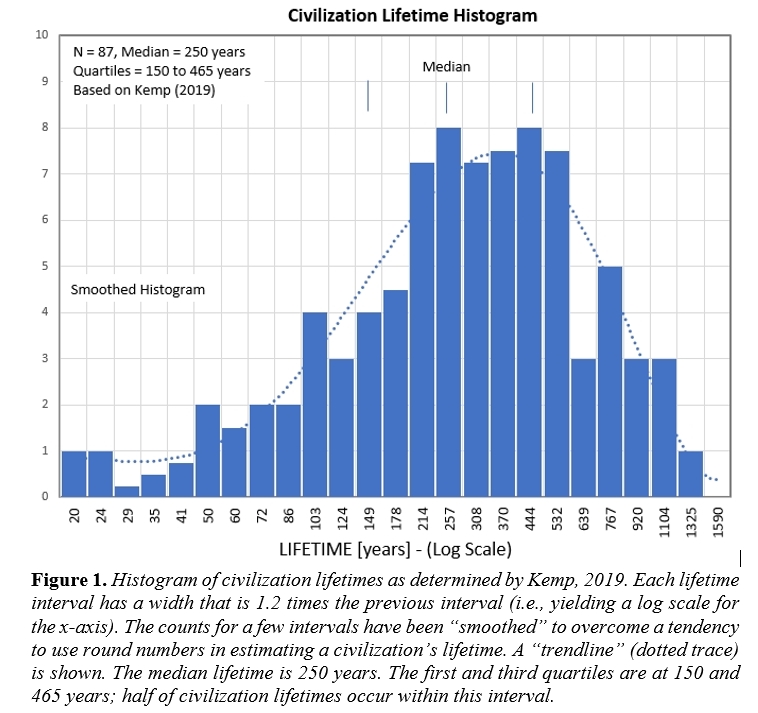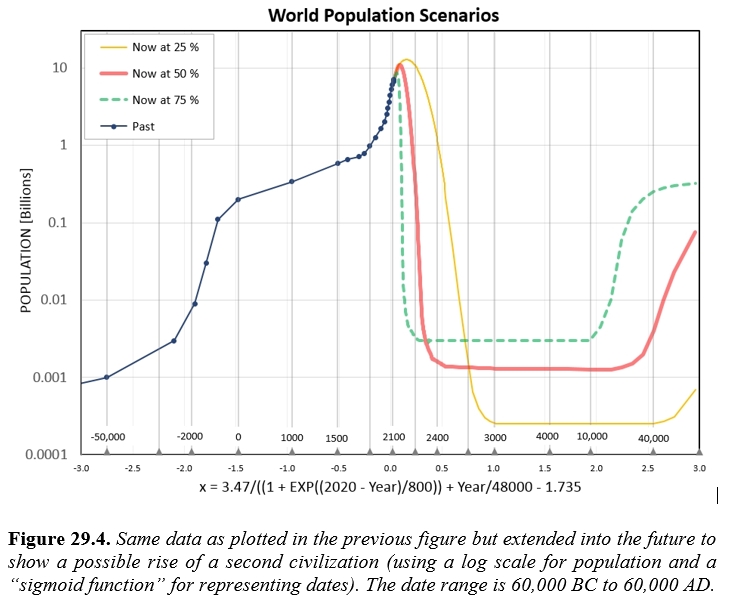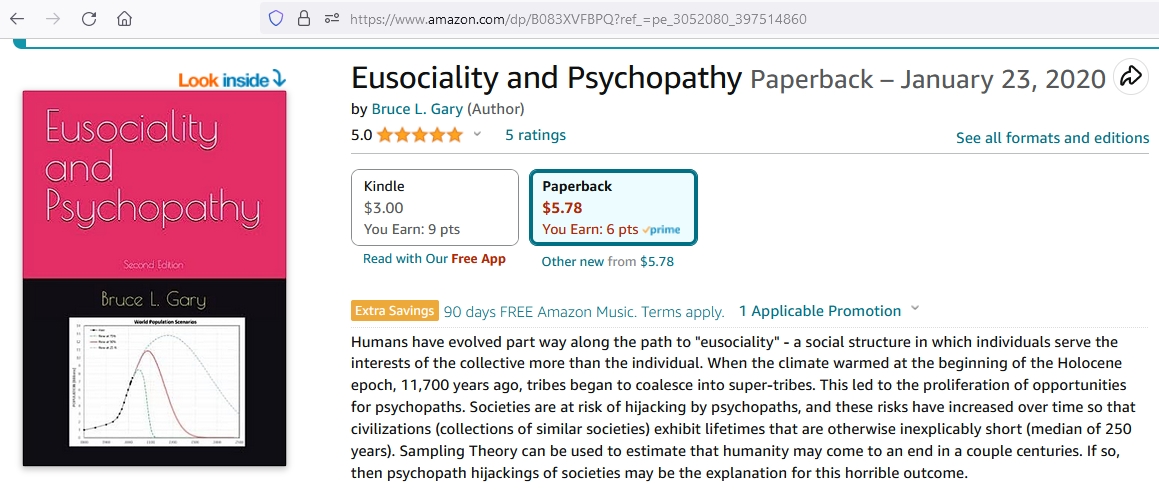Bruce L. Gary, 2023.10.07.
The Holocene’s 11,700 years is too short for
significant genetic evolution to have occurred; yet, cultural
changes have happened at a furious rate. Since essentially all
of the new Holocene culturgens were never experienced by our
Pleistocene ancestors our genetically created nature has no
wisdom to draw upon for evaluating and either accepting or
rejecting them. This is why the Holocene’s many amazing
civilizations are at such a high risk of collapsing.
Consequently, it is unsurprising that many
people are not only discontent with civilization, but they
secretly want to destroy it and return to an ancient lifestyle
of small tribes (where everyone knows everyone), simple
strivings (hunting and gathering), the calm of the country (no
cities) and a sense of a community that can be relied upon to
support each tribesman (Gary, 2019). This
discontent can accumulate and become an organized destructive
force. Every society faces times challenged by disintegration,
and sometimes recovery fails, and collapse occurs (Turchin,
2023).
Instincts that served the Pleistocene tribe
will have appeal. Nationalism will grow, and there will be an
unwillingness to cooperate with neighboring societies. During
the Pleistocene, when a tribe felt threatened by the prospect
of inter-tribal warfare, the tribesmen supported elevating a
prominent person to the position of “strong leader” and
adopting a hierarchical social organization (Fog, 2020).
Psychopaths may only represent 0.8 % of men, and 0.1 % of
women (Kiehl, 2014), but they employ an uncanny sense for what
their victims want (Hare, 1992) and are able to exert an
over-sized influence on a society's culture. They will seek
leadership by promising a return to some past time, when
things were great – i.e., to a faintly remembered Pleistocene
setting.
This is now a global trend. Societies that
have been hijacked by psychopaths become autocracies, which
eventually evolve into fascist kleptocracies. This is most
clearly illustrated by Putin's Russia. A kleptocracy is not
only incapable of solving societal problems, it is unmotivated
to do so. As the rest of the world's hoi poloi clamor
for a return to when times were great, a subconsciously
remembered version of the Pleistocene, we must face the
prospect that the civilized world is doomed!
During most of the Holocene societies were
not in communication with each other, so when one collapsed
the others didn’t. But during the past century societies
became linked in many ways, so we now risk seeing one collapse
trigger the others. Global warming is a prime example of this
dangerous inter-connectedness. Because global warming and
associated climate changes strain all societies, frustration
of the populous with their governance will be widespread.
Good people may remain optimistic about the
future, but their constructive efforts are small and futile.
It is possible that humanity will undergo a massive die-off
starting this century, and the end-point will be where we were
before the Holocene. The global population could then be only
a few million. Everyone would be living in tribes of 100 to
200 people - hunting and gathering, living without city
comforts, and constantly concerned about an attack by a
neighbor tribe.
As it was in the beginning, so shall it be in
the end.
The end.
_______________________________________________________________________________
Here are a couple figures from my latest book on the subject:



I want to restate the
killer ape idea by suggesting that only some humans are
descended in this way. However,
this is genetically impossible, so instead I will invoke a
little-known theory
for animal behavior called “eusociality.”
The ants are the most famous
eusocial
species because they illustrate the key concept of individual
behavior that is
100 % devoted to supporting their collective, the colony. So
far, only 17
species have been identified as fully eusocial (Wilson, 2014).
E. O. Wilson has
suggested that humans are
partially eusocial (Wilson, 2012). A requirement for a
transition toward eusociality is that
groups of individuals compete with each other. Ant colonies do
this, but to
some extent so do chimpanzees.
Chimpanzee troops of 50 to 150
individuals
compete for territory with fruit trees and other food sources. A
small group is
routinely devoted to border patrol duty. The border patrollers
protect territorial
borders and look for opportunities to kill small groups of
neighbor troop individuals
as a way to not only weaken the neighbor troop but also expand
the home
troop territory.
A key concept for
understanding eusociality is that when
groups of individuals compete there are evolutionary rewards for
groups that
consist of individuals with a range of talents. For example, one
troop niche is
border patrolling, another is tool-making, hunting, leadership,
etc.
Present-day
humans consist of individuals with a variety of talents. During
the 2.5 million
years of the Pleistocene human tribes had memberships totaling
100 to 200
individuals. In a small tribe everyone knows everyone, so when
they formed a team
they must have been able to optimize talents to form the most
effective team. There
could have been a team for hut construction, another for
tool-making, hunting,
and of course, border patrolling. Who was best suited for border
patrolling?
The descendants of killer apes!
The genes for different
talents are present in
proportions of individuals that best serve the tribe. In other
words, artisan genes
(for tool- and weapon-making) should be found in 5 to 10 % of
men, so that a
tribe with a total population of 150, with 50 adult men, would
have 3 to 5 men
who are good at artisan tasks (at least one of whom would be
assigned for
artisan duty). At any given time at least one man should serve
as tribal chief, so a similar percentage of
men would have genes for that talent. A greater percentage of
men would have
the killer gene since border patrolling teams (for chimps as
well as human primitive tribes) consist
of about 5 to 10 individuals. The killer gene percentage should
therefore be ~ 20
%. The presence of genes for producing talents for optimum group
performance is
a well-developed theory in sociobiology; it is referred to as
“evolutionarily
stable strategy” – or ESS.
I have described this matter
in great detail in my
book Eusociality and Psychopathy. I conclude that humans
have elaborated ESS to include a sophisticated response to
changes in a tribe's social condition. Instead of every tribe
producing 20 % of killers, the newly-evolved human ESS produces
~ 40 % of humans who are capable of adopting the killer
personality if that is optimum for their society. In other
words, as the ESS varies so does the incidence of people
expressing the killer personality. Using
psychological testing results for “Right Wing Authoritarianism”
(RWA) it was
established that among societies that were measured in 2020, 6 %
to 26 % of the population had high RWA scores. I suggest that
the need for killer people varies from close to zero to maybe 40
% depending on the level of fear in a society. I speculate that
~ 40 % of a typical contemporary population is capable of
becoming killers and that at any given time the incidence of the
killer personality is somewhere within the range 0 to 40 %. A
politically incorrect question that begs an answer: "Do some
racial populations have different pre-killer maxima than 40 %?"
References
Ardry, Robert, 1961, African Genesis, New York:
Atheneum
Fog, Agner, 2017, Warlike
and Peaceful Societies: The Interaction of Genes and Culture,
Open Book Publishers, UK
Gary, Bruce, 2019, Civility and its Discontents,
Reductionist Publications, Hereford, AZ
Hare, Robert D.,1993, Without Conscience: The Disturbing
World of the Psychopath Among Us, The Guilford Press, New
York
Kiehl, Kent A., 2014, The Psychopath Whisperer: The Science
of Those Without Conscience, Crown Publishers, New York
Lumsden, Charles and Edward Wilson, 1981, Genes, Mind and
Culture: The Coevolutionary Process, Harvard University
Press, Cambridge, Mass.
Turchin, Peter, 2023, End Times, Elites, Counter-Elites and
the Path of Political Disintegration, Penguin Press, New
York
Wilson, Edward O., 2012, The
Social Conquest of Earth, New York: Liveright
Publishing Corporation
Wilson, Edward O., 2014, The Meaning of Human Existence,
New York: Liveright Publishing Corporation